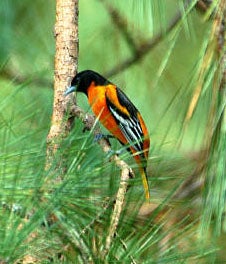SCIENTIFIC NAME:
Icterus galbula
STATUS:
Breeder. Common to fairly common in spring and fall, rare in winter, and occasional in summer in Gulf Coast region. In Tennessee Valley region, fairly common in spring and fall, rare in summer, and occasional in winter. In Mountain and Inland Coastal Plain regions, fairly common in spring and fall, and rare in summer and winter. Low Conservation Concern.
DESCRIPTION:
The baltimore oriole, a neotropical migrant, belongs to the family of birds Icteridae. This family also includes other orioles, meadowlarks, and blackbirds. Adult birds range in size from 6.75 to 7.75 inches, with the male slightly larger than the female. Weight ranges from 1 to 1.5 ounces. Wingspan is from 9 to 12 inches. Adult males are colored bright orange on the chest, belly, shoulder and rump. All other parts are black. Adult males have black wings with orange and white barring. Adult females are definitely lighter in coloration compared to their male counterparts. Their underparts are a lightly colored orange-yellow. Female wings are brown with two bars. Immature birds vary in coloration but most often resemble the female. Birds have a straight, pointed bill. Vocalization is a flute-like whistle. Communication can also occur with displays and posturing.
DISTRIBUTION:
The breeding range is eastern North America including west to Wisconsin and south to central Mississippi and Alabama, east to the western Carolinas. Most birds winter in Southern Mexico, Central America and Northern South America.
HABITAT:
Prefers open, hardwood forests but are adaptable to suburban areas. Birds rarely found in agricultural areas.
FEEDING HABITS:
Birds may be found foraging in trees and shrubs. Primary food source is caterpillars, but other insects are also consumed and several pest species are utilized. . Berries and nectar are also part of the oriole’s food choices. Orioles are drawn to feeders containing orange halves, grape jelly or nectar.
LIFE HISTORY AND ECOLOGY:
These birds are not a gregarious (social) species. Males are the first to arrive in the breeding territory. Courting displays include bowing, perch hopping, and singing. Females build pouch nest on the ends of hanging branches. Clutch size ranges from 4 to 6 eggs. Females incubate the eggs for 12 to 14 days. Both parents feed the nestlings which remain under parent care for two weeks. Birds are preyed upon by avian and mammalian predators. Orioles can be an important component in local control of pest caterpillars, especially the forest tent caterpillar.
REFERENCES:
A Field Guide to the Birds – Eastern Land and Water Birds. 1934. Roger Tory Peterson Ed. Houghton Mifflin Company, Boston, MA. 230 pp
Bachynski, Kathleen. https://animaldiversity.org/accounts/Icterus_galbula/
2/23/09
Unknown http://en.wikipedia.org/wiki/Baltimore_Oriole
2/23/09
AUTHOR: Richard Tharp, Wildlife Biologist, Division of Wildlife and Freshwater Fisheries






